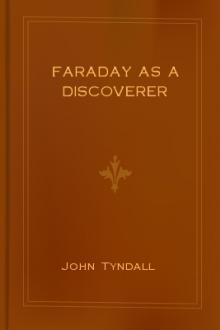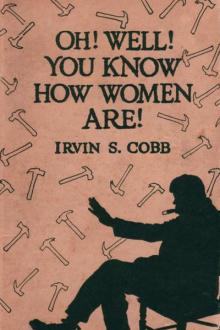The Chemical History of a Candle by Michael Faraday (detective books to read TXT) 📕

- Author: Michael Faraday
- Performer: -
Book online «The Chemical History of a Candle by Michael Faraday (detective books to read TXT) 📕». Author Michael Faraday
[Illustration: Fig. 15]
Suppose I take another glass jar, empty of all but air: if I examine it with a taper, I shall find that it contains nothing but air. I will now take this jar full of the gas that I am speaking of, and deal with it as though it were a light body. I will hold both upside-down, and turn the one up under the other; and that which did contain the gas procured from the steam, what does it contain now? You will find it now only contains air. But look! Here is the combustible substance [taking the other jar] which I have poured out of the one jar into the other. It still preserves its quality, and condition, and independence, and therefore is the more worthy of our consideration, as belonging to the products of a candle.
Now, this substance which we have just prepared by the action of iron on the steam or water, we can also get by means of those other things which you have already seen act so well upon the water. If I take a piece of potassium, and make the necessary arrangements, it will produce this gas; and if, instead, a piece of zinc, I find, when I come to examine it very carefully, that the main reason why this zinc cannot act upon the water continuously as the other metal does, is because the result of the action of the water envelopes the zinc in a kind of protecting coat. We have learned in consequence, that if we put into our vessel only the zinc and water, they by themselves do not give rise to much action, and we get no result. But suppose I proceed to dissolve off this varnish—this encumbering substance—which I can do by a little acid; the moment I do this, I find the zinc acting upon the water exactly as the iron did, but at the common temperature. The acid in no way is altered, except in its combination with the oxide of zinc, which is produced. I have now poured the acid into the glass, and the effect is as though I were applying heat to cause this boiling up. There is something coming off from the zinc very abundantly, which is not steam. There is a jar full of it; and you will find that I have exactly the same combustible substance remaining in the vessel, when I hold it upside-down, that I produced during the experiment with the iron barrel. This is what we get from water—the same substance which is contained in the candle.
[Illustration: Fig. 16.]
Let us now trace distinctly the connection between these two points. This is hydrogen—a body classed among those things which in Chemistry we call elements, because we can get nothing else out of them. A candle is not an elementary body, because we can get carbon out of it; we can get this hydrogen out of it, or at least out of the water which it supplies. And this gas has been so named hydrogen, because it is that element which, in association with another, generates water. [Footnote: [greek: hudos], "water," and [greek: gennao], "I generate."] Mr. Anderson having now been able to get two or three jars of gas, we shall have a few experiments to make, and I want to shew you the best way of making these experiments. I am not afraid to shew you, for I wish you to make experiments, if you will only make them with care and attention, and the assent of those around you. As we advance in Chemistry, we are obliged to deal with substances which are rather injurious, if in their wrong places—the acids, and heat, and combustible things we use, might do harm if carelessly employed. If you want to make hydrogen, you can make it easily from bits of zinc, and sulphuric or muriatic acid. Here is what in former times was called the "philosopher's candle." It is a little phial with a cork, and a tube or pipe passing through it.
[Illustration: Fig. 17.]
And I am now putting a few little pieces of zinc into it. This little instrument I am going to apply to a useful purpose in our demonstrations—for I want to shew you that you can prepare hydrogen, and make some experiments with it as you please at your own homes. Let me here tell you why I am so careful to fill this phial nearly, and yet not quite full. I do it because the evolved gas, which, as you have seen, is very combustible, is explosive to a considerable extent when mixed with air, and might lead to harm, if you were to apply a light to the end of that pipe before all the air had been swept out of the space above the water. I am now about to pour in the sulphuric acid. I have used very little zinc, and more sulphuric acid and water, because I want to keep it at work for some time. I therefore take care in this way to modify the proportions of the ingredients, so that I may have a regular supply—not too quick, and not too slow. Supposing I now take a glass and put it upside-down over the end of the tube, because the hydrogen is light I expect that it will remain in that vessel a little while. We will now test the contents of our glass to see if there be hydrogen in it. I think I am safe in saying we have caught some [applying a light]. There it is, you see. I will now apply a light to the top of the tube. There is the hydrogen burning. There is our philosophical candle. It is a foolish feeble sort of a flame, you may say; but it is so hot that scarcely any common flame gives out so much heat. It goes on burning regularly, and I am now about to put that flame to burn under a certain arrangement, in order that we may examine its results and make use of the information which we may thereby acquire. Inasmuch as the candle produces water, and this gas comes out of the water, let us see what this gives us by the same process of combustion that the candle went through when it burnt in the atmosphere; and for that purpose I am going to put the lamp under this apparatus, in order to condense whatever may arise from the combustion within it In the course of a short time you will see moisture appearing in the cylinder, and you will get the water running down the side; and the water from this hydrogen flame will have absolutely the same effect upon all our tests, being obtained by the same general process as in the former case. This hydrogen is a very beautiful substance. It is so light that it carries things up: it is far lighter than the atmosphere; and I dare say I can shew you this by an experiment which, if you are very clever, some of you may even have skill enough to repeat. Here is our generator of hydrogen, and here are some soap-suds. I have an india-rubber tube connected with the hydrogen generator, and at the end of the tube is a tobacco-pipe.
[Illustration: Fig. 18.]
I can thus put the pipe into the suds, and blow bubbles by means of the hydrogen. You observe how the bubbles fall downwards when I blow them with my warm breath; but notice the difference when I blow them with hydrogen. [The Lecturer here blew bubbles with hydrogen, which rose to the roof of the theatre.] It shews you how light this gas must be in order to carry with it not merely the ordinary soap-bubble, but the larger portion of a drop hanging to the bottom of it. I can shew its lightness in a better way than this; larger bubbles than these may be so lifted up; indeed, in former times balloons used to be filled with this gas. Mr. Anderson will fasten this tube on to our generator, and we shall have a stream of hydrogen here with which we can charge this balloon made of collodion. I need not even be very careful to get all the air out, for I know the power of this gas to carry it up. [Two collodion balloons were inflated, and sent up, one being held by a string.] Here is another larger one made of thin membrane, which we will fill and allow to ascend. You will see they will all remain floating about until the gas escapes.
What, then, are the comparative weights of these substances? I have a table here which will shew you the proportion which their weights bear to each other. I have taken a pint and a cubic foot as the measures, and have placed opposite to them the respective figures. A pint measure of this hydrogen weighs three-quarters of our smallest weight (a grain), and a cubic foot weighs one-twelfth of an ounce; whereas a pint of water weighs 8,750 grains, and a cubic foot of water weighs almost 1,000 ounces. You see, therefore, what a vast difference there is between the weight of a cubic foot of water and a cubic foot of hydrogen.
Hydrogen gives rise to no substance that can become solid, either during combustion or afterwards as a product of its combustion. But when it burns, it produces water only; and if we take a cold glass and put it over the flame, it becomes damp, and you have water, produced immediately in appreciable quantity; and nothing is produced by its combustion but the same water which you have seen the flame of the candle produce. It is important to remember that this hydrogen is the only thing in nature which furnishes water as the sole product of combustion.
And now we must endeavour to find some additional proof of the general character and composition of water; and for this purpose I will keep you a little longer, so that at our next meeting we may be better prepared for the subject. We have the power of arranging the zinc which you have seen acting upon the water by the assistance of an acid, in such a manner as to cause all the power to be evolved in the place where we require it I have behind me a voltaic pile, and I am just about to shew you, at the end of this lecture, its character and power, that you may see what we shall have to deal with when next we meet. I hold here the extremities of the wires which transport the power from behind me, and which I shall cause to act on the water.
We have previously seen what a power of combustion is possessed by the potassium, or the zinc, or the iron-filings; but none of them shew such energy as this. [The Lecturer here made contact between the two terminal wires of the battery, when a brilliant flash of light was produced.] This light is, in fact, produced by a forty-zinc power of burning: it is a power that I can carry about in my hands, through these wires, at pleasure—although, if I applied it wrongly to myself, it would destroy me in an instant, for it is a most intense thing, and the power you see here put forth while you count five [bringing the poles in contact, and exhibiting the electric light] is equivalent to the power of several thunder-storms, so great is its force[14]. And that you may see what intense energy it has, I will take the ends of the wires which convey the power from the battery, and with it I dare say I can burn this iron file. Now, this is a chemical





Comments (0)